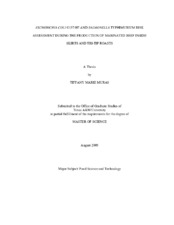| dc.description.abstract | This study was conducted to determine the survival of Escherichia coli O157:H7 and Salmonella Typhimurium in marinade that was used to vacuum tumble beef inside skirts and beef tri-tip roasts. The depth of penetration of each microorganism into the individual meat products, and the survival of these microorganisms in the products as well as marinade stored over time were evaluated. Two commercial marinades were used, Reo TAMU Fajita Marinade and Legg's Cajun Style Marinade. Eighteen beef inside skirts and 18 tri-tips were used during this study. Both inside skirts and tri-tips were vacuum tumbled for a total of 1 h. Samples of products were tested immediately following tumbling (day 0), or were vacuum packaged and stored in the cooler (approximately 2 degrees C) to be tested 7 and 14 days following tumbling. Samples of the spent marinade were taken and tested initially following tumbling (day 0), and were also stored in a cooler and tested 3 and 7 days after the marinade was used. The results of the study showed that with both marinades S. Typhimurium and E. coli O157:H7 penetrated throughout the skirt meat. After having been stored for 7 days following tumbling, the log value of both S. Typhimurium and E. coli O157:H7 decreased in the meat. After 14 days of storage following tumbling, the log value of both S. Typhimurium and E. coli O157:H7 continued to decrease; however, both pathogens were still detectable. The penetration of the pathogens in the tri-tip roast varied depending on the thickness of the roast. The thicker roasts had undetectable levels of both pathogens in the geometric center; however, the thinner tri-tip roasts had detectable levels at the geometric center. The spent marinade tested on day 0, 3, and 7 showed that the microorganisms were able to survive in the marinade at refrigerated temperatures. The results of this study demonstrated that pathogens may penetrate into the interior of beef skirts and tri-tips during vacuum tumbling with contaminated marinade, and that pathogens survive during refrigerated storage of spent marinade. Industry should consider these data when evaluating potential food safety risks associated with the production of vacuum tumbling beef products. | en |


